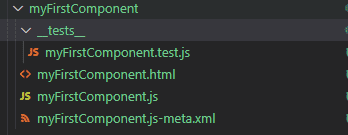First Jest Test file
To test the component we should have our LWC component ready. So let's create the component.
Create a LWC component for testing
- First create a component called
myFirstComponent - Add the following code to the
myFirstComponent.js,myFirstComponent.htmlandmyFirstComponent.js-meta.xmlfiles
import { LightningElement } from 'lwc';
export default class MyFirstComponent extends LightningElement {
greeting = 'World';
}<template>
<lightning-card title="Hello" icon-name="custom:custom14">
<div class="slds-var-m-around_medium first">
Hello, {greeting}!
</div>
<div class="slds-var-m-around_medium second">
My, {greeting}!
</div>
</lightning-card>
</template><?xml version="1.0" encoding="UTF-8"?>
<LightningComponentBundle xmlns="http://soap.sforce.com/2006/04/metadata" fqn="templateToggleDemo">
<apiVersion>49.0</apiVersion>
<isExposed>true</isExposed>
<targets>
<target>lightning__AppPage</target>
<target>lightning__RecordPage</target>
<target>lightning__HomePage</target>
</targets>
</LightningComponentBundle>Create Your First Jest Test File
- Add a
__tests__folder under your component - Add
__tests__folder to.forceignoreso that it’s not deployed to your org - Create a file with your component name and give an extension
.test.jsas shown below.

Create Your test cases for the component
import {createElement} from 'lwc'
import MyFirstComponent from 'c/myFirstComponent'
describe('c-my-first-component test suite', ()=>{
test('display first greeting', ()=>{
const element = createElement('c-my-first-component', {
is:MyFirstComponent
})
document.body.appendChild(element)
const firstDiv = element.shadowRoot.querySelector('div.first')
expect(firstDiv.textContent).toBe('Hello, World!')
})
test('display second greeting', () => {
const element = createElement('c-my-first-component', {
is: MyFirstComponent
})
document.body.appendChild(element)
const secondDiv = element.shadowRoot.querySelector('div.second')
expect(secondDiv.textContent).toBe('My, World!')
})
})In line 1. we are importing the createElement method from the lwc that will help us to create a new element
In line 2. We are importing our MyFirstComponent from the path ie. c/myFirstComponent
In line 4. We have created the describe block for organizing test cases in logical groups of tests. We have given the name c-my-first-component test suite name to the describe block and within this block, we are writing our test cases
In line 6. We have created our first test block in which we are going to test that our first div block has content Hello, World! or not
In line 7-9 we are creating the element using createElement method and loading the HTML of our myFirstComponent component within the element that we are creating.
Behind the scene, it will become like this
<c-my-first-component>
<!-- component template will come here -->
</c-my-first-component>In line 10. we are attaching the element created at line 7 to the JSDOM body tag.
In line 11. We are fetching the reference of the div that has class first and storing to variable firstDiv
In line 12. we are checking the text withing the div is correct or not using the toBe matcher.
Run Your test cases
You can run your test case using the following command
npm run test:unit -t myFirstComponent.test.js // this command for running single file
npm run test:unit // this command for running all the test filesOutput
After running the test cases you will see the following output
